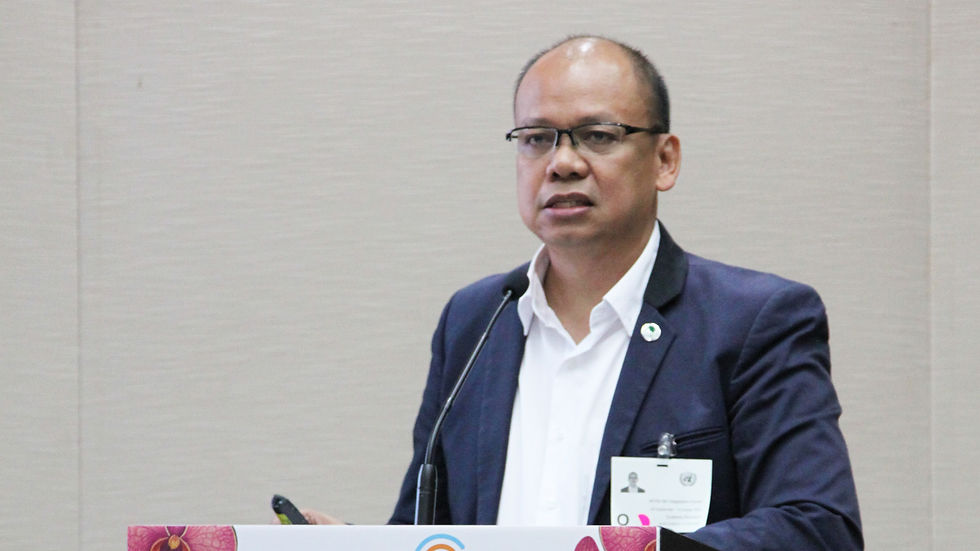AIT participates in the UNFCCC Talanoa Dialogue and shares a powerful story about ambition
- May 8, 2018
- 4 min read
Updated: Feb 12, 2025

On Sunday, 6 May 2018, the Asian Institute of Technology participated as a Non-Party stakeholder at the the UNFCCC May intersessional Talanoa Dialogue taking place at the UN Campus in Bonn, Germany.
The Talanoa Dialogue was launched at COP23 in November 2017 following a mandate to convene a facilitative dialogue among Parties to take stock of collective efforts to reduce emissions and build greater resilience, in line with the long-term goals of the Paris Agreement and to inform the preparation of Nationally Determined Contributions (NDCs). Ultimately, the goal is to help countries increase the ambition of their NDCs by 2020.
Seven Talanoa groups ("Talanoas") were set up on Sunday, each consisting of about 35 participants: 30 Party representatives and 5 non-Party stakeholder representatives. Each Talanoa was asked to work in parallel and engage in an in-depth discussion to address three central topics:
Where are we?
Where do we want to go?
How do we get there?
The discussions were conducted following the spirit of the Pacific tradition of Talanoa. Talanoa is a traditional approach used in Fiji and the Pacific to share stories, build empathy and trust, and engage in an inclusive, participatory and transparent dialogue.
Each panelist was invited to prepare analytical, policy relevant, and solution-oriented stories, responding to at least one of the three guiding questions. The following is the story shared by Ms. Qing Xia, Senior Programme Specialist at AIT RRC.AP, in response to Question 2 (Where do we want to go?):
Hello everyone,
I’m Qing from the Asian Institute of Technology, which is based in Bangkok, Thailand.
The story I want to share with you today is about “ambition”: Ambition to achieve self-empowerment; ambition to accelerate climate actions; and ambition to promote a trajectory of a 1.5 o C pathway.
In 2008, the Republic of Marshall Islands declared a state of economic emergency because it can no longer afford to import diesel to generate power. They were heavily impacted by unprecedented price surges of petroleum in the global market.
In the following year, the government endorsed the National Energy Policy and Energy Action Plan with the aim to resolve the energy crisis and pursue renewable energy deployment in the nation.
Around the same time in 2009, William Reiher was recruited by the government to work on an LED street lighting project. This was the first time William got involved in the energy efficiency and renewable energy domain.
William taught himself how to conduct energy audits; he attended training workshops and learned about the benefits of energy efficiency and using renewable energy. William realized a business opportunity and started his company in 2010, named Green Energy Solutions. William saw the potential to drastically reduce energy consumption by making consumers aware of their energy consumption patterns. And this has always led to behavioural change among William’s clients.
To complement his energy audits, William invested USD 25,000 of his own money to introduce energy efficient appliances in the Marshall Islands.
Through the combination of energy consumption behavioural change and utilizing energy efficient appliances, William’s clients were able to save 30-50% from their energy bills – benefits that everybody understands. The College of Marshall Islands, for example, had reduced their bill from USD 700,000 to USD 300,000 a year because of using William’s services and advices.
William then expanded his services to include offering and installing standalone solar systems for his clients. He also offered training courses on energy auditing and solar installation to locals with the purpose to encourage more people on energy consumption behavioural change.
Since then, William successfully turned the USD 25,000 seed investment into a USD 200,000 company. William had successfully proven a business case for energy efficiency and renewable energy in the Marshall Islands.
With the aim to scale up and replicate his business model beyond the Marshall Islands, William attended our Regional Workshop on Accelerating Renewable Energy Deployment in Small Island Developing States in 2017 to learn how to write project concept notes for the Green Climate Fund, and explore potential funding opportunities. That was where we met and learned about William.
So, where do we want to go? We want to be in a society that encourages everyone to be like William. Where we can all change our behavior, consume less energy, and produce energy only from renewable sources.
The mission of AIT is to build long-term national and regional capacity through formal degree programmes, short-term professional training, and applied research in Asia and the Pacific.
Under our flagship programme: Climate Change Asia, we empower developing countries to gain direct access to climate finance. We have trained 724 participants from 37 countries since 2016.
We believe countries can achieve self-empowerment through participation in capacity building activities and effectuate a paradigm shift and transformative change towards low-emission, climate-resilient development pathways.
Thank you all for listening.

Following the May sessions, a formal summary of the procedure and substance of the Talanoa Dialogue during the May sessions will be made available. More information on the Talanoa Dialogue can be found here.


